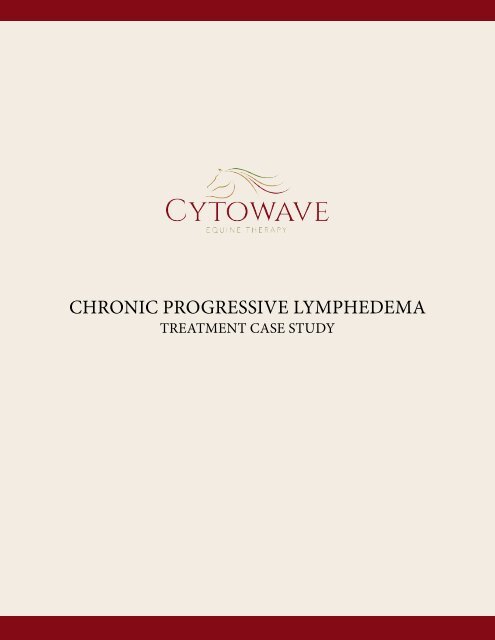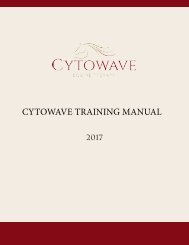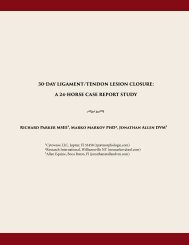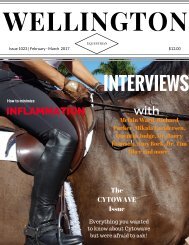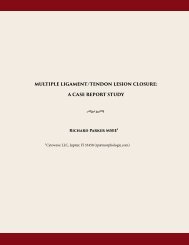Chronic Progressive Lymphedema
CPL in horses can be a devastating disease. We're hoping that Cytowave will change that.
CPL in horses can be a devastating disease. We're hoping that Cytowave will change that.
You also want an ePaper? Increase the reach of your titles
YUMPU automatically turns print PDFs into web optimized ePapers that Google loves.
CHRONIC PROGRESSIVE LYMPHEDEMA<br />
TREATMENT CASE STUDY
◊◊<br />
CYTOWAVE EQUINE THERAPY PROPOSAL<br />
FOR CHRONIC PROGRESSIVE LYMPHEDEMA<br />
I).<br />
II).<br />
III).<br />
IV).<br />
V).<br />
What is Cytowave Equine Therapy?<br />
CPL Treatment Case Study Timel ine<br />
Cytowave Equine Therapy treatments for CPL<br />
Interview with Emily Jewell<br />
Cytowave Equine Equipment for CPL<br />
VI). Cytowave Equipment Purchase Price<br />
VII). Cytowave Rent to Own Program
Special Feature • Cytowave<br />
Cytowave – A new medical therapy technology<br />
Reliably reduces recovery times from serious tendon and ligament injuries by 5 months<br />
By Richard Parker, Chief Technical Officer, CytoWave<br />
Cytowave is a patented,<br />
non-invasive treatment based<br />
on tissue specific signals.<br />
While other devices in the<br />
equine market use generic<br />
electromagnetic waveforms,<br />
Cytowave offers a tissue<br />
specific analytic method<br />
based on the biology of<br />
the injury. The tissue signal<br />
is derived based upon the<br />
difference in biomagnetic<br />
signals from normal and<br />
injured tissues. This<br />
proprietary SQUID Therapy<br />
Signal (STS) is amplified and<br />
delivered via a mild magnetic<br />
field. This new technology<br />
has been embraced by many<br />
top veterinarians and is being<br />
used as an adjunct to stem<br />
cell therapy or PRP.<br />
The Basics of CytoWave Technology<br />
Equine tendon and ligament injuries occur frequently in both competitive and companion<br />
animals. Unfortunately, this type of trauma does not lend itself to fast, non-invasive recovery<br />
techniques. Disorders of these tendons often become chronic and are difficult to manage<br />
successfully. In most cases, recovery is prolonged for many months and even years.<br />
It is theorized that the mechanism for accelerating the closure of ligament and tendon lesions<br />
is found in the nature of the electromagnetic signals impressed on the subject. The specific<br />
and complex activity known as the “healing process” is an expression of the local activity of<br />
electromagnetic fields, as their generation is spontaneous and inevitable due to ionic and<br />
charged particle flow.<br />
CytoWave Therapy technology takes<br />
an actual electromagnetic signal<br />
given off by the body at an injury site,<br />
stores and then amplifies that signal<br />
before re-admitting to the subject so<br />
as to accelerate the healing process.<br />
This “jump-start” occurs because<br />
the signal applied to the injury is very<br />
similar to the same signal the horse<br />
produces. That signal, therefore, is<br />
readily accepted on a cellular level<br />
and processed in such a manner as<br />
to accelerate the recovery.<br />
Opposing coils held by a boot apparatus deliver<br />
the CytoWave STSTM signal<br />
Thus, we have a targeted, tissue specific physical therapy which can be used for soft (muscle<br />
and nerve), dense (tendons and ligaments) and hard (bone splinters or hairline fractures) tissue<br />
injuries.<br />
Cytowave derived signals contrasted with the much older PEMF technology.<br />
“We’ve used Cytowave<br />
most effectively for<br />
tendon injuries, some<br />
suspensory branch<br />
injuries, it’s been very<br />
helpful.”<br />
— Dr. Tim Ober,<br />
United States Equestrian Team<br />
Simple older PEMF signals<br />
very common in the industry<br />
Actual physiological waveform<br />
which looks nothing like PEMF<br />
Cytowave signals from actual<br />
measurements accelerating repair<br />
These signals have been reported to operate about four times faster than PEMF systems and<br />
obtain consistent results in the 90% range; instead of the 60% range such as is the case with<br />
other popular technologies. As Cytowave uses tissue-specific signals, it is able to achieve<br />
consistent results unlike other technologies which treat every injury the same. In fact, we very<br />
rarely have a failure to close a serious lesion, reduce deep tissue inflammation, relieve sore<br />
back discomfort or accelerate bone fracture repair.<br />
http://bit.ly/EQS2015Summer<br />
16 | Henry Schein Animal Health ph: (855) HSAH-EQ1 (472-4371) | fx: (888) 329-3861 | www.henryscheinvet.com
◊◊<br />
Below are a set of images from two severe injuries. The first set of<br />
images show a fracture of the C4 vertebrae in a horse that slipped<br />
on ice. The first scan, taken at the time of the injury shows the<br />
severity of the fracture. The second image was taken after 8 weeks<br />
of treatment using the Cytowave fracture program.<br />
We have found that the Normalizing Signal Waveform (the<br />
mathematical difference between the injury waveform and healthy<br />
waveform) contains information about therapeutic recovery<br />
representing the biological activity of the body in affecting the<br />
injury repair. This signal can be applied using an external complex<br />
signal generator which contains the recorded waveform patterns,<br />
connected to a coil applicator delivery system, as shown in the<br />
process diagram of patent 7,361,136 (2):<br />
Figure 1 – Development of the STS signal<br />
The second set of images below is from a 24 year old horse that<br />
suffered a lesion covering 75% of a tendon. Typically, Cytowave<br />
can close a serious lesion in 3 to 5 weeks in a young, healthy horse<br />
but given the advanced age of the subject, the healing process<br />
was much longer. The horse has begun rehabilitation after 13<br />
weeks of treatment that closed the lesion and substantially reduced<br />
inflammation.<br />
This patented technology is now being routinely implemented by<br />
CytoWave LLC (3, 4, 5, 6,) in a series of studies and production<br />
installations for equine applications in preparation for an FDA filing.<br />
This technique described as SQUID Signal Therapy (STSTM) has<br />
the effect of rapidly accelerating the closure of ligament and tendon<br />
lesions from a typical 6-12 months healing time to a nominal 3-5<br />
weeks (4).<br />
Both cases represent severe and difficult to heal injuries but the<br />
images clearly illustrate that Cytowave technology, utilizing Squid<br />
Therapy Signals , can effectively influence normal and injury<br />
currents, thus contributing to, and accelerating the healing.<br />
STS (Squid Therapy Signal)<br />
The development of the SQUID (Superconducting QUantum<br />
Interference Device) makes it possible to discover natural magnetic<br />
field waveforms as a further extension of magnetic field therapy<br />
technology. As the waveform is theorized to contain the intelligence<br />
of the biological functions taking place locally, it is also proposed<br />
that detection and generation of the proper waveform associated<br />
with a given healing process would be an essential component of an<br />
optimal waveform delivery device designed to accelerate the healing<br />
process by delivering that same waveform, in an amplified form.<br />
This proposition was addressed in the paper of Parker and Markov<br />
SQUID-Based Electromagnetic Fields – a Plausible Tool for<br />
Treatment of Tendon Injuries (1). This paper included procedures in<br />
identifying, extracting and isolating characteristics of magnetic fields<br />
emanating from both healthy and injured or diseased portions of the<br />
body. The goal is to discover the pattern revealed in signals which<br />
are expressed by the ”healing component”, and then delivering<br />
those same magnetic field patterns which have a therapeutic effect,<br />
as described in the patent “Method and Apparatus for Generating a<br />
Therapeutic Magnetic Field”, 7,361,136 (2).<br />
NOTE: this material extracted from the paper “The Treatment of Tendon Injury with<br />
Electromagnetic Fields Evidenced by Advanced Ultrasound Image Processing”, Richard<br />
Parker, Marko Markov, 2014 obtained through CytoWave LLC<br />
References<br />
1. Parker R., and M. Markov, (2014) SQUID-Based Electromagnetic Fields – A Plausible Tool<br />
for Treatment of Tendon Injuries at the Karolinska Institut, Department of Molecular Medicine<br />
and Surgery Stockholm, Sweden, May 2014<br />
2. Parker R.F. (2008) Patent #7,361,136, “Method and Apparatus for Generating a<br />
Therapeutic Magnetic Field”.<br />
3. Parker R., M. Markov, and J. Allen (in press) 30-Day Ligament/Tendon Lesion Closure: A<br />
24-Horse Case Report Study. submitted to the American Association of Equine Practitioners<br />
(AAEP) for the Salt Lake City Conference, December 2014.<br />
4. Parker R. and M. Markov (2015) Electromagnetic Fields in Treatment of Tendon Injury<br />
in Human And Veterinary Medicine. in Markov M (ed) Biological Effects of Electromagnetic<br />
Fields, CRC Press, Boca Raton FL 435-454<br />
5. Markov M. and R. Parker (2012) Electromagnetic Fields in Sports Injuries. Karolinska<br />
Conference on Sports Medicine, Stockholm.<br />
6. Markov M. and R. Parker (2012) Analytical Versus Empirical Design of EMF devices.<br />
BEMS Annual meeting, Halifax, June 16-19, 2012<br />
Cytowave’s technology was granted protection from the US patent office. This technology<br />
was presented at various international meetings such as Scandinavian Congress of Sports<br />
Medicine, VI International Workshop on Biological Effects of Electromagnetic Fields, XXXIIIth<br />
Annual meeting of BEMS and published in peer-reviewed scientific journals.<br />
Call us today at (844) 298-9283 or visit us at<br />
www.cytowave.com to learn more about our programs.<br />
About the Author Chief Technical Officer Richard Parker<br />
has over 35 years of business experience and has been awarded<br />
the central patent on the CytoWave process. Richard is a former<br />
computer microprocessor designer and has also sponsored his own<br />
successful companies in real estate development, and in the energy<br />
field. Richard has focused his attention on the field of biomagnetic<br />
therapy for the past 20 years, where he is a frequently invited speaker<br />
at international venues and has published 14 papers in refereed<br />
scientific journals. Richard earned a B.S. in Electrical Engineering<br />
from the University of Florida and an M.S. in Electrical Engineering<br />
from the Georgia Institute of Technology.<br />
Summer 2015 | eqs | 17
<strong>Chronic</strong> <strong>Progressive</strong> <strong>Lymphedema</strong><br />
Treatment Case Study TIME LINE<br />
On April, 27th 2016, Cytowave treatments were started on a Friesian stallion for <strong>Chronic</strong> <strong>Progressive</strong> <strong>Lymphedema</strong><br />
(CPL). The following therapy report represents the first ninety (90) day case study period.<br />
All documentation was reported by Emily Jewell, owner of Keegan and Grace & Beauty Farms, and John Dovenmuehle,<br />
Cytowave Equine Therapy representative. Photographs taken by Emily Jewell.<br />
HISTORY OF SUBJECT:<br />
Horse: Keegan, Friesian stallion<br />
Age: 13 years old<br />
Height: 16.3 hands<br />
Weight: 1400 Lbs.<br />
Owners: Emily and Mike Jewell<br />
Grace and Beauty Farms<br />
Carlisle, IN.<br />
Environmental Conditions:<br />
Keegan kept in dry stall area. Stall is exceptionally neat and cleaned every day.<br />
Treatments are in the Farrier area of barn with Keegan standing on rubber pads.<br />
Exercise: Daily exercise in round pen. Clean dry area.<br />
Emily has owned Keegan since his birth and has trained him for show events and movies. He is considered a<br />
member of her family, which of course he is. Emily first noticed signs of CPL when Keegan was around 5-6 years<br />
old. Small nodules had appeared on Keegan’s rear legs, behind the hoofs. The symptoms spread from the right<br />
rear leg to the left rear leg, then progressed to the two front legs.<br />
The right rear leg has three (3) larger nodules and a large fold under the nodules. The left rear leg has two (2)<br />
larger nodules and a smaller fold under the nodules.<br />
The two front legs have small lesions with small nodules on both legs. The front legs are not in the trial program<br />
but we are observing them to see if there are improvements without treatment.<br />
OBJECTIVE:<br />
We determined that Keegan was in the second stages of the disease. Our first objective was to reduce inflammation<br />
by increasing circulation and lymphatic flow. We also wanted to relieve any soreness and pain in the rear<br />
legs and to make Keegan comfortable and give his body a chance to begin healing naturally.<br />
Currently Cytowave therapy does not have a pre-set program for CPL so we determined the best program would<br />
be aimed at controlling CPL by reducing inflammation. Treatments for this objective are to run continuously<br />
for two (2) weeks. We discussed the results of the treatments daily and based off of our results, set up the next<br />
treatments.
◊◊<br />
TREATMENTS:<br />
We started Cytowave Inflammation/Maintenance treatments on Keegan’s rear legs where the CPL was most<br />
severe. The Inflammation/ Maintenance treatment is a thirty minute noninvasive treatment. We treated the rear<br />
legs, using a dual application with foreleg therapy boots. The boots were placed on top of the coronary band<br />
with coils on the side of the legs. The therapy boots, coils and Cytowave equipment were applied and administered<br />
by Emily.<br />
RESULTS:<br />
DAYS 1-7<br />
▶ A noted decrease in inflammation / swelling in the rear legs was observed after four (4) days of treatments.<br />
▶ Circulation and lymph flow appeared to have increased and there was a marked decrease in the size of the<br />
cannon bone.<br />
▶ The nodules and folds are softer, and more pliable, not as hard to touch. There is a little dampness and oily<br />
feeling in the back of the hoof.<br />
▶ The therapy boots are easier to apply, due to the swelling in the legs subsiding.<br />
At the end of first week of treatments, Keegan was more relaxed and visibly comfortable. He is more active when<br />
Emily turns him out in the pen to exercise and Keegan, has started to canter for the first time in 4 years.<br />
Note the shaved area on the hoof on the image to the left. This is where the canon bone was measured daily. The<br />
other two images show the nodule formation and the swollen cannon bone on Keegans leg.
These images show the affected areas - note the shave areas to the right that show the reduction in the folds<br />
DAYS 7-21<br />
Cytowave treatments used: Tendon / Ligament treatment program.<br />
▶ The continued reduction in inflammation and swelling indicates lymphatic vessels are opening.<br />
▶ Cannon bone swelling also continues to reduce in size.<br />
▶ Folds in the rear of the legs are not has thick and are separating. Folds and nodules are softer and more pliable.<br />
▶ Still some dampness and oily feeling in the crease of the back of the hoof area. Lesions continue to heal and are<br />
drier and smaller.<br />
▶ Keegan’s rear legs are not as sensitive in the area of the nodules. Emily is able to massage his legs without any<br />
discomfort.<br />
▶ Keegan is noticeably feeling better. He is more active, and runs and bucks in the open pen area.<br />
This series of images show the shrunken nodules and folds on Keegan’s legs.
◊◊<br />
DAYS 22-36<br />
Changed Cytowave treatment program to Buck Shins. Lesions on rear legs continue to heal<br />
▶ Swelling and inflammation continue to reduce in size and lymphatic vessels have opened. The cannon bone<br />
measures at 10 ½” down from 12 ½”.<br />
▶ Keegan is running in the arena after treatments and for the first time in four years he is cantering.<br />
DAYS 37-51<br />
Cytowave treatment program changed to bone fracture.<br />
▶ Reduction in swelling continues which we believe is due to decreasing inflammatory response of the lymphatic<br />
vessel.<br />
▶ Folds are decreasing in size and feel softer and more pliable. Nodules are smaller. Emily massages Keegan’s<br />
pastern areas which also helps increase the Lymphatic flow and circulation.<br />
▶ Dampness and oily feeling decreases. The area under the feathers feels drier.<br />
▶ Keegan continues to be more active, running and jumping in the lunging arena.<br />
DAYS 52-66<br />
Continuing with Bone Fracture treatment based on Keenan’s continued progress.<br />
▶ Nodules and folds continue to decrease in size.<br />
▶ Emily continues to manually massage rear legs and continues to exercise Keegan after treatments, which helps<br />
keep the lymphatic vessels and circulation flowing.<br />
DAYS 67-81<br />
Emily continued Cytowave Bone Fracture treatments. Due to a heavy summer schedule, the treatments were<br />
limited to three (3) per week. Of note, Keegan’s condition stayed the same even after reducing the number of treatments.<br />
Swelling and inflammation did not increase, which indicates the quality of healing is substantial.<br />
DAYS 81- 95<br />
Based on Keenan’s condition, the three (3) treatments per week are continued.<br />
▶ There is no increase with inflammation and swelling or in the size of the nodules and folds during this period.<br />
▶ Rear legs and cannon bone size remains the same.<br />
Note: Keegan is in the Breyer Fest Show in Kentucky and his trainer mentions that Keegan’s control is better than<br />
it has been in many years and there is a significant difference in Keegan’s performance.<br />
95 DAYS<br />
Emily has started treating Keegan with Cytowave Bone Fracture treatments every day.<br />
▶ To date, Keegan has not relapsed as his treatments continue.<br />
▶ There is no further inflammation, or swelling on Keegan’s legs.
Keegan continues to enjoy his treatments and his energy level is high.<br />
VETERINARIAN EVALUATION<br />
Dr. Royal visits periodically during treatment sessions. He notes that the swelling and inflammation has drastically<br />
reduced. Keegan is in very good health.<br />
▶ Keegan’s HR = 36, RR=18 and Weight is 1400#<br />
▶ His BAR, (Bright, Alert, Responsive), is excellent.<br />
▶ He is sound with little sensitivity in the folds of his legs.<br />
“Nodule’s are shrinking because of better Lymph flow. Inflammatory response up the leg is getting better because of<br />
decreasing inflammatory response of the lymphatic vessel...From a clinical standpoint, the Cytowave treatment’s are<br />
significant.”<br />
Dr. Royal<br />
Royal Veterinary Service<br />
Odon, IN.
◊◊<br />
CYTOWAVE EQUINE THERAPY<br />
TREATMENTS FOR CPL<br />
This is the first documented case of CPL being treated with Cytowave therapy. These are our recommendations<br />
based on the outcome of this case study in which Cytowave seems to have stopped the progression of the CPL<br />
and resulted in reversing the condition. To date, the subject has not relapsed and his Cytowave treatments<br />
continue.<br />
There are three (3) different Cytowave treatment programs that were used to control the progression of CPL in<br />
Keegan:<br />
1) Inflammation<br />
2) Tendon / Ligament<br />
3) Bone Fracture<br />
As with any injury, the inflammation treatment program should always be used first. One of the strengths of<br />
Cytowave therapy is the ability to quickly reduce pain and inflammation. Results are more noticeable with an<br />
“edema” based disease such as CPL. Starting with the 30 minute inflammation also allows a horse to get used to<br />
wearing the treatment applicators and gives the owner a chance to observe how the horse responds to the<br />
treatments.<br />
With stage 1 CPL, the Tendon / Ligament treatments can be used after starting with the Inflammation treatment<br />
program. The Cytowave Tendon/Ligament treatment programs can have a very positive effect on reducing<br />
soreness, pain and swelling.<br />
For stage 2 & 3, it is recommended to follow the same process as you would with stage 1 CPL. Start with the<br />
inflammation treatment for 2 - 3 days, then to the Tendon/Ligament program for approximately one week. If<br />
there are continued signs of healing, you can progress to the Bone Fracture treatment program. The Bone<br />
Fracture treatment program is recommended for use when nodules and folds are present in the legs.<br />
As with all Cytowave treatment programs, your horse will tell you if the program is having a positive outcome.<br />
If you use the Tendon/Ligament program for several days and notice that the healing progress has plateaued,<br />
return to using the inflammation program.<br />
The inflammation program appears to help control CPL. The number of maintenance treatments needed depend<br />
on the condition of the CPL and how the horse responds to the treatments. It is safe to use the inflammation (30<br />
minutes) up to three times a day.<br />
Before the start of any Cytowave treatment programs, it is recommended you consult your veterinarian. The<br />
Cytowave Representatives will also consult with your veterinarian and explain the Cytowave technology,<br />
treatments and results that we are trying to achieve. The Cytowave Corporate office staff are available to assist<br />
with any questions regarding the treatments as well.
AN INTERVIEW WITH EMILY JEWELL<br />
Emily and Mike Jewell own a small farm in southern Indiana and they breed and raise Friesian and Andalusian<br />
horses. At any given time they care for 10 or more horses, a few of which are Friesian and Andalusian mares.<br />
They stand two stallions, an Andalusian and their pride and joy Friesian stallion Keegan. Keegan is the celebrity<br />
in their area and has appeared in several magazines such as Horse Illustrated and Horse and Rider. Keegan and<br />
some of their other horses have been used in several Farnam ads. Keegan has really made a name for himself and<br />
Grace and Beauty farms with all of his accomplishments.<br />
Emily understands that when it comes to horses, there is no shortage of maladies that they can suffer from. For<br />
example, Emily noticed something was wrong with one of her Freisians when they were around 5 or 6 years old.<br />
Small nodules had appeared on the horse’s rear legs, just behind the hoofs. At first Emily thought the horse<br />
had scratches, but when the condition worsened, she researched and discovered that this was the early stage of<br />
<strong>Chronic</strong> <strong>Progressive</strong> <strong>Lymphedema</strong> (CPL), a lymphatic disorder that many draft horses, including Friesians are<br />
predisposed to.<br />
Emily began treating her Friesian horse to slow the advancement of CPL but results were not positive. In spite of<br />
her efforts, the symptoms spread from the right rear leg to the left rear leg, then progressed to the two front legs.<br />
She began to fear the inevitable - since there is no known cure, most heavy bodied horses with CPL have to be<br />
euthanized around 15 years old.<br />
By chance, Emily was approached at a horse show by John Dovenmuehle who told her about Cytowave. “When<br />
he said “inflammation reduction” I really perked up,” Emily said.<br />
At this point, she was ready to try anything to slow down the progress of this relentless, inflammation based disease.<br />
Cytowave did not have a specific CPL based set of therapy signals, but it did have a robust pain/inflammation<br />
program that had proven effective with other inflammation based conditions, including cellulitis. “At first,<br />
I didn’t know what to think. We had tried everything up to this point but really didn’t have anything to lose.”<br />
Emily stated.<br />
On April 27th, 2016, Emily began to use Cytowave treatments exclusively on her horse. After only 4 days of<br />
treatments, Emily noticed the inflammation had decreased. After the first week, the inflammation in the rear legs<br />
and the Cannon bone size had decreased as well. The nodules and the folds were softer, not as hard to the touch<br />
and the Cytowave boots were easier to wrap around his legs<br />
due to the decreased swelling.<br />
The shift in her horse’s demeanor underscored that positive<br />
physical changes were taking place. “He was more relaxed and<br />
comfortable. When I let him out in the pen, he was more active,<br />
running and bucking,” Emily said.<br />
After eight (8) days, the inflammation and Canon bone swelling<br />
continued to decrease. The folds in the rear legs were not<br />
as thick and were separating. Folds and nodules were softer and<br />
more pliable. There was still some dampness and oily feeling in<br />
the creases of the back hoof area but overall, the lesions were<br />
drier and reducing in size. And for the first time in weeks she<br />
was able to massage his legs without any discomfort.
◊◊<br />
“He really began enjoying getting his legs massaged after his treatments,” Emily continued. “Overall he just seems<br />
really happy. I did not realize how much the disease had slowly robbed him of his spirit over the years because it<br />
was so gradual. Once he started feeling better, I realized I was getting my old horse back!”<br />
In the span of 10 days, measurements showed that the swelling had been substantially reduced. The Canon bone<br />
showed the most dramatic reduction in size, with the left leg going from 12 ½” to 10 ½”.<br />
On May 11th, Dr. Royal evaluated her horse and he noted that the Cytowave treatments had drastically reduced<br />
the swelling and inflammation. He said her horse seemed to be in very good health and his BAR (Bright, Alert,<br />
Responsive) was excellent. He was in very good health, sound, with little sensitivity in the folds of his legs.<br />
After twenty one (21) days of treatments, Emily continued to see positive results in slowing the progression of<br />
the CPL condition. The size of the folds and nodules decreased and lesions in the rear legs were drier and smaller.<br />
Pain and sensitivity in the folds of his legs lessened. His overall health improved and it was apparent that her<br />
horse felt much better.<br />
“At first he stamped his feet and was a bit agitated until he got used to the boots,” Emily said. “Now it’s a walk in<br />
the park for him and he really enjoys the treatments.”<br />
Her horse will continue with treatments and hopefully completely recover. As for Emily? She was so impressed<br />
with the results that she is now working for Cytowave to help promote their new technology.<br />
CONTACT INFORMATION:<br />
Emily Jewell - Grace and Beauty Farms<br />
Carlisle IN<br />
812-691-1839
EQUIPMENT COST FOR CPL<br />
Controller/ Computer - $4,500.00 (Refurbished)<br />
➢With three programs, and one maintenance/inflammation program<br />
➢Includes, 25’ extension cable, 12’ break away cable and test magnet<br />
➢Included treatment program (Maintenance/Inflammation) and client picks an<br />
➢additional 2 treatments: choice of –<br />
Fracture<br />
Ligament/Tendon<br />
Bucked Shins<br />
Hock/Knee/Joint<br />
Complete Leg Applicator Kit- $675.00 (value of $710.00)<br />
➢Includes one therapy boot, oblong coils (set), belt pockets (set)<br />
➢two belts and two snaps<br />
Additional-$650.00 (value of $710.00)<br />
➢One therapy boot, oblong coils (set), boot pockets (set), two belts and two snaps.<br />
➢One 20” “Y” connector (value of $80.00)<br />
Warranty<br />
➢3 years, on Controller/Computer<br />
➢1 year, on Coils<br />
➢3 months, Applicators<br />
Replacement/Repair<br />
➢Advance Replacement/Repair of all, applicators and accessories<br />
➢Optional, loaner available for advanced replacement of controller/computer. No<br />
➢Charge if determined purchased controller/computer os covered by warranty.<br />
Insurance<br />
➢$1800.00/ one year, (equivalent to $150.00/month), can only purchase at onset of<br />
Agreement.<br />
➢Must be paid in full, with payment of purchased agreement<br />
All Cytowave products are made in the USA. All products are assembled for each order individual order.
◊◊<br />
CPL - RENT TO OWN PROGRAM<br />
1. $550.00 paid monthly<br />
2. $550.00 deposit one-time payment<br />
3. After 6 months client can either return items or all monies can be applied to purchase<br />
including deposit. If client decided to keep unit longer than 6 months at 9 months 75% of<br />
rental monies can be applied towards purchase. At 1yr client can apply 50% of rental money<br />
towards purchase, or property must be returned to company<br />
4. $5,525.00 total purchase price, excluding tax.<br />
Rent to Own Program provides the following Cytowave Equipment:<br />
➢Controller/ Computer - (Refurbished)<br />
➢With two programs, and maintenance/inflammation program<br />
➢Includes, 25’ extension cable, 12’ break away cable and test magnet<br />
➢Ligament/Tendon program<br />
➢Bone Fracture program<br />
➢Retail purchase price is over, $13,500.00<br />
Complete Leg Applicator Kit-<br />
➢Includes one therapy boot, oblong coils (set), belt pockets (set)<br />
➢two belts and two snaps.<br />
Retail purchase price is, $710.00<br />
Additional Cytowave equipment, add $40.00/ month<br />
➢One therapy boot, oblong coils (set), boot pockets (set), two belts and<br />
two snaps.<br />
➢One 20”, “Y” connector<br />
Regular retail price is, $795.00
CYTOWAVE EQUIPMENT FOR CPL<br />
Cytowave Equine therapy equipment includes:<br />
➢Controller/Computer-<br />
➢Pre set programs for CPL treatments<br />
Inflammation<br />
Tendon/Ligament<br />
Fracture Bone<br />
➢25’ Extension cable, 12’ breakaway cable<br />
➢Foreleg therapy boots (2)<br />
➢Foreleg Therapy Boot Pockets<br />
➢Leg coil Belts (4), used for stabilization<br />
➢Boot snaps- (4) extra, attaches to coil pockets<br />
➢Oblong Coils (2) sets, fits Foreleg Boot Pockets<br />
➢20” “Y” cable<br />
➢Test Magnet


